Life Cycle Assessment on Different Synthetic Routes of ZIF-8 Nanomaterials
Abstract
:1. Introduction
1.1. ZIF-8 Applications
1.2. Life Cycle Assessment of Nanomaterials
2. Materials and Methods
2.1. Goal and Scope
2.2. Life Cycle Inventory Analysis
3. Results
3.1. Environmental Analysis of Different Synthetic Routes
3.2. Sensitivity Analysis—Effect of Diversifying the Energy Sources
4. Conclusions
Author Contributions
Funding
Acknowledgments
Conflicts of Interest
References
- Arnall, A.; Parr, D. Moving the Nanoscience and Technology (NST) Debate Forwards: Short-Term Impacts, Long-Term Uncertainty and the Social Constitution. Technol. Soc. 2005, 27, 23–38. [Google Scholar] [CrossRef]
- Kousis, I.; Pisello, A.L. For the Mitigation of Urban Heat Island and Urban Noise Island: Two Simultaneous Sides of Urban Discomfort. Environ. Res. Lett. 2020, 15, 103004. [Google Scholar] [CrossRef]
- Wang, H.; Zhu, Q.-L.; Zou, R.; Xu, Q. Metal-Organic Frameworks for Energy Applications. Chem 2017, 2, 52–80. [Google Scholar] [CrossRef] [Green Version]
- Qiu, T.; Liang, Z.; Guo, W.; Tabassum, H.; Gao, S.; Zou, R. Metal–Organic Framework-Based Materials for Energy Conversion and Storage. ACS Energy Lett. 2020, 5, 520–532. [Google Scholar] [CrossRef] [Green Version]
- Li, H.; Wang, K.; Sun, Y.; Lollar, C.T.; Li, J.; Zhou, H.-C. Recent Advances in Gas Storage and Separation Using Metal–Organic Frameworks. Mater. Today 2018, 21, 108–121. [Google Scholar] [CrossRef]
- Aniruddha, R.; Sreedhar, I.; Reddy, B.M. MOFs in Carbon Capture-Past, Present and Future. J. CO2 Util. 2020, 42, 101297. [Google Scholar] [CrossRef]
- Hu, Z.; Wang, Y.; Shah, B.B.; Zhao, D. CO2 Capture in Metal–Organic Framework Adsorbents: An Engineering Perspective. Adv. Sustain. Syst. 2019, 3, 1800080. [Google Scholar] [CrossRef] [Green Version]
- Cohen, S.M. Modifying MOFs: New Chemistry, New Materials. Chem. Sci. 2010, 1, 32–36. [Google Scholar] [CrossRef]
- Mertzenich, C.L.; Papaefstathiou, G.S.; Friščić, T.; Hamilton, T.D.; Bučar, D.-K.; Swenson, D.C.; MacGillivray, L.R. Inverted metal–organic frameworks: Isoreticular decoration with organic anions using principles of supramolecular chemistry. J. Coord. Chem. 2021, 74, 169–177. [Google Scholar] [CrossRef]
- Kitagawa, S.; Kitaura, R.; Noro, S. Functional Porous Coordination Polymers. Angew. Chem. Int. Ed. 2004, 43, 2334–2375. [Google Scholar] [CrossRef] [PubMed]
- Papadaki, D.; Kiriakidis, G.; Tsoutsos, T. Chapter 11—Applications of Nanotechnology in Construction Industry. In Fundamentals of Nanoparticles: Classifications, Synthesis Methods, Properties and Characterization; Barhoum, A., Hamdy Makhlouf, A.S., Eds.; Micro and Nano Technologies; Elsevier: Amsterdam, The Netherlands, 2018; pp. 343–370. [Google Scholar] [CrossRef]
- Shafique, M.; Luo, X. Nanotechnology in Transportation Vehicles: An Overview of Its Applications, Environmental, Health and Safety Concerns. Materials 2019, 12, 2493. [Google Scholar] [CrossRef] [PubMed] [Green Version]
- Singh, T.; Shukla, S.; Kumar, P.; Wahla, V.; Bajpai, V.K.; Rather, I.A. Application of Nanotechnology in Food Science: Perception and Overview. Front. Microbiol. 2017, 8. [Google Scholar] [CrossRef] [PubMed] [Green Version]
- Xu, X.; Wang, H.; Liu, J.; Yan, H. The Applications of Zeolitic Imidazolate Framework-8 in Electrical Energy Storage Devices: A Review. J. Mater. Sci. Mater. Electron. 2017, 28, 7532–7543. [Google Scholar] [CrossRef]
- Burtch, N.C.; Jasuja, H.; Walton, K.S. Water Stability and Adsorption in Metal–Organic Frameworks. Chem. Rev. 2014, 114, 10575–10612. [Google Scholar] [CrossRef]
- Xie, L.-H.; Xu, M.-M.; Liu, X.-M.; Zhao, M.-J.; Li, J.-R. Hydrophobic Metal–Organic Frameworks: Assessment, Construction, and Diverse Applications. Adv. Sci. 2020, 7, 1901758. [Google Scholar] [CrossRef]
- Sann, E.E.; Pan, Y.; Gao, Z.; Zhan, S.; Xia, F. Highly Hydrophobic ZIF-8 Particles and Application for Oil-Water Separation. Sep. Purif. Technol. 2018, 206, 186–191. [Google Scholar] [CrossRef]
- Park, K.S.; Ni, Z.; Côté, A.P.; Choi, J.Y.; Huang, R.; Uribe-Romo, F.J.; Chae, H.K.; O’Keeffe, M.; Yaghi, O.M. Exceptional Chemical and Thermal Stability of Zeolitic Imidazolate Frameworks. Proc. Natl. Acad. Sci. USA 2006, 103, 10186–10191. [Google Scholar] [CrossRef] [Green Version]
- Phan, A.; Doonan, C.J.; Uribe-Romo, F.J.; Knobler, C.B.; O’Keeffe, M.; Yaghi, O.M. Synthesis, Structure, and Carbon Dioxide Capture Properties of Zeolitic Imidazolate Frameworks. Acc. Chem. Res. 2010, 43, 58–67. [Google Scholar] [CrossRef]
- Banerjee, R.; Phan, A.; Wang, B.; Knobler, C.; Furukawa, H.; O’Keeffe, M.; Yaghi, O.M. High-Throughput Synthesis of Zeolitic Imidazolate Frameworks and Application to CO2 Capture. Science 2008, 319, 939–943. [Google Scholar] [CrossRef]
- Chen, B.; Yang, Z.; Zhu, Y.; Xia, Y. Zeolitic Imidazolate Framework Materials: Recent Progress in Synthesis and Applications. J. Mater. Chem. A 2014, 2, 16811–16831. [Google Scholar] [CrossRef]
- Hwang, S.; Chi, W.S.; Lee, S.J.; Im, S.H.; Kim, J.H.; Kim, J. Hollow ZIF-8 Nanoparticles Improve the Permeability of Mixed Matrix Membranes for CO2/CH4 Gas Separation. J. Membr. Sci. 2015, 480, 11–19. [Google Scholar] [CrossRef]
- Castro-Muñoz, R.; Fíla, V. Effect of the ZIF-8 Distribution in Mixed-Matrix Membranes Based on Matrimid® 5218-PEG on CO2 Separation. Chem. Eng. Technol. 2019, 42, 744–752. [Google Scholar] [CrossRef]
- Cousin Saint Remi, J.; Rémy, T.; Van Hunskerken, V.; van de Perre, S.; Duerinck, T.; Maes, M.; De Vos, D.; Gobechiya, E.; Kirschhock, C.E.A.; Baron, G.V.; et al. Biobutanol Separation with the Metal–Organic Framework ZIF-8. ChemSusChem 2011, 4, 1074–1077. [Google Scholar] [CrossRef]
- Xue, W.; Zhou, Q.; Li, F.; Ondon, B.S. Zeolitic Imidazolate Framework-8 (ZIF-8) as Robust Catalyst for Oxygen Reduction Reaction in Microbial Fuel Cells. J. Power Sources 2019, 423, 9–17. [Google Scholar] [CrossRef]
- Zhu, M.; Srinivas, D.; Bhogeswararao, S.; Ratnasamy, P.; Carreon, M.A. Catalytic Activity of ZIF-8 in the Synthesis of Styrene Carbonate from CO2 and Styrene Oxide. Catal. Commun. 2013, 32, 36–40. [Google Scholar] [CrossRef]
- Olaniyan, B.; Saha, B. Comparison of Catalytic Activity of ZIF-8 and Zr/ZIF-8 for Greener Synthesis of Chloromethyl Ethylene Carbonate by CO2 Utilization. Energies 2020, 13, 521. [Google Scholar] [CrossRef] [Green Version]
- Cardoso, J.C.; Stulp, S.; de Brito, J.F.; Flor, J.B.S.; Frem, R.C.G.; Zanoni, M.V.B. MOFs Based on ZIF-8 Deposited on TiO2 Nanotubes Increase the Surface Adsorption of CO2 and Its Photoelectrocatalytic Reduction to Alcohols in Aqueous Media. Appl. Catal. B Environ. 2018, 225, 563–573. [Google Scholar] [CrossRef] [Green Version]
- Huang, Z.; Dong, P.; Zhang, Y.; Nie, X.; Wang, X.; Zhang, X. A ZIF-8 Decorated TiO2 Grid-like Film with High CO2 Adsorption for CO2 Photoreduction. J. CO2 Util. 2018, 24, 369–375. [Google Scholar] [CrossRef]
- Chang, C.-W.; Kao, Y.-H.; Shen, P.-H.; Kang, P.-C.; Wang, C.-Y. Nanoconfinement of Metal Oxide MgO and ZnO in Zeolitic Imidazolate Framework ZIF-8 for CO2 Adsorption and Regeneration. J. Hazard. Mater. 2020, 400, 122974. [Google Scholar] [CrossRef]
- Khan, I.U.; Othman, M.H.D.; Jilani, A.; Ismail, A.F.; Hashim, H.; Jaafar, J.; Rahman, M.A.; Rehman, G.U. Economical, Environmental Friendly Synthesis, Characterization for the Production of Zeolitic Imidazolate Framework-8 (ZIF-8) Nanoparticles with Enhanced CO2 Adsorption. Arab. J. Chem. 2018, 11, 1072–1083. [Google Scholar] [CrossRef]
- Yang, S.; Lu, S.; Cheng, Y.; Lu, Z.; Liu, X.; Qin, Y.; Zhao, R.; Zheng, L.; Cao, Q. HDBB@ZIF-8 Fluorescent Nanoprobe with Hereditary Alcohols Selectivity for Chemical Sensing. Microporous Mesoporous Mater. 2020, 294, 109959. [Google Scholar] [CrossRef]
- Zhan, M.; Hussain, S.; AlGarni, T.S.; Shah, S.; Liu, J.; Zhang, X.; Ahmad, A.; Javed, M.S.; Qiao, G.; Liu, G. Facet Controlled Polyhedral ZIF-8 MOF Nanostructures for Excellent NO2 Gas-Sensing Applications. Mater. Res. Bull. 2021, 136, 111133. [Google Scholar] [CrossRef]
- Matatagui, D.; Sainz-Vidal, A.; Gràcia, I.; Figueras, E.; Cané, C.; Saniger, J. Improving Sensitivity of a Chemoresistive Hydrogen Sensor by Combining ZIF-8 and ZIF-67 Nanocrystals. Proceedings 2017, 1, 462. [Google Scholar] [CrossRef] [Green Version]
- Lin, X.; Gao, G.; Zheng, L.; Chi, Y.; Chen, G. Encapsulation of Strongly Fluorescent Carbon Quantum Dots in Metal–Organic Frameworks for Enhancing Chemical Sensing. Anal. Chem. 2014, 86, 1223–1228. [Google Scholar] [CrossRef] [PubMed]
- Sun, C.-Y.; Qin, C.; Wang, X.-L.; Yang, G.-S.; Shao, K.-Z.; Lan, Y.-Q.; Su, Z.-M.; Huang, P.; Wang, C.-G.; Wang, E.-B. Zeolitic Imidazolate Framework-8 as Efficient PH-Sensitive Drug Delivery Vehicle. Dalton Trans. 2012, 41, 6906–6909. [Google Scholar] [CrossRef] [PubMed]
- Vasconcelos, I.B.; da Silva, T.G.; Militão, G.C.G.; Soares, T.A.; Rodrigues, N.M.; Rodrigues, M.O.; da Costa, N.B.; Freire, R.O.; Junior, S.A. Cytotoxicity and Slow Release of the Anti-Cancer Drug Doxorubicin from ZIF-8. RSC Adv. 2012, 2, 9437–9442. [Google Scholar] [CrossRef]
- He, L.; Wang, T.; An, J.; Li, X.; Zhang, L.; Li, L.; Li, G.; Wu, X.; Su, Z.; Wang, C. Carbon Nanodots@zeolitic Imidazolate Framework-8 Nanoparticles for Simultaneous PH-Responsive Drug Delivery and Fluorescence Imaging. CrystEngComm 2014, 16, 3259–3263. [Google Scholar] [CrossRef]
- García Palacín, M.; Martínez, J.I.; Paseta, L.; Deacon, A.; Johnson, T.; Malankowska, M.; Téllez, C.; Coronas, J. Sized-Controlled ZIF-8 Nanoparticle Synthesis from Recycled Mother Liquors: Environmental Impact Assessment. ACS Sustain. Chem. Eng. 2020, 8, 2973–2980. [Google Scholar] [CrossRef]
- Luo, H.; Cheng, F.; Huelsenbeck, L.; Smith, N. Comparison between Conventional Solvothermal and Aqueous Solution-Based Production of UiO-66-NH2: Life Cycle Assessment, Techno-Economic Assessment, and Implications for CO2 Capture and Storage. J. Environ. Chem. Eng. 2021, 9, 105159. [Google Scholar] [CrossRef]
- Grande, C.A.; Blom, R.; Spjelkavik, A.; Moreau, V.; Payet, J. Life-Cycle Assessment as a Tool for Eco-Design of Metal-Organic Frameworks (MOFs). Sustain. Mater. Technol. 2017, 14, 11–18. [Google Scholar] [CrossRef]
- Feijoo, S.; González-García, S.; Moldes-Diz, Y.; Vazquez-Vazquez, C.; Feijoo, G.; Moreira, M.T. Comparative Life Cycle Assessment of Different Synthesis Routes of Magnetic Nanoparticles. J. Clean. Prod. 2017, 143, 528–538. [Google Scholar] [CrossRef]
- Sendão, R.; del Valle Martínez deYuso, M.; Algarra, M.; Esteves da Silva, J.C.G.; Pinto da Silva, L. Comparative Life Cycle Assessment of Bottom-up Synthesis Routes for Carbon Dots Derived from Citric Acid and Urea. J. Clean. Prod. 2020, 254, 120080. [Google Scholar] [CrossRef]
- Papadaki, D.; Foteinis, S.; Mhlongo, G.H.; Nkosi, S.S.; Motaung, D.E.; Ray, S.S.; Tsoutsos, T.; Kiriakidis, G. Life Cycle Assessment of Facile Microwave-Assisted Zinc Oxide (ZnO) Nanostructures. Sci. Total Environ. 2017, 586, 566–575. [Google Scholar] [CrossRef]
- James, F.; Consoli, F.; Denison, R.; Dickson, K.; Mohin, T.; Vigon, B. A Conceptual Framework for Life-Cycle Impact Assessment; Society of Environmental Toxicology and Chemistry and SETAC Foundation for Environmental Education, Inc.: Pensacola, FL, USA, 1993; Available online: https://cdn.ymaws.com/www.setac.org/resource/resmgr/books/lca_archive/impact_assessment.pdf (accessed on 1 June 2021).
- Kousis, I.; Fabiani, C.; Ercolanoni, L.; Pisello, A.L. Using Bio-Oils for Improving Environmental Performance of an Advanced Resinous Binder for Pavement Applications with Heat and Noise Island Mitigation Potential. Sustain. Energy Technol. Assess. 2020, 39, 100706. [Google Scholar] [CrossRef]
- Finkbeiner, M. The International Standards as the Constitution of Life Cycle Assessment: The ISO 14040 Series and Its Offspring. In Background and Future Prospects in Life Cycle Assessment; Klöpffer, W., Ed.; LCA Compendium—The Complete World of Life Cycle Assessment; Springer: Dordrecht, The Netherlands, 2014; pp. 85–106. [Google Scholar] [CrossRef]
- ReCiPe 2016: A Harmonized Life Cycle Impact Assessment Method at Midpoint and Endpoint Level Report I: Characterization 2016-0104. Available online: https://www.rivm.nl/bibliotheek/rapporten/2016-0104.html (accessed on 26 May 2021).
- Frischknecht, R.; Jungbluth, N.; Althaus, H.-J.; Doka, G.; Dones, R.; Heck, T.; Hellweg, S.; Hischier, R.; Nemecek, T.; Rebitzer, G.; et al. The Ecoinvent Database: Overview and Methodological Framework (7 Pp). Int. J. Life Cycle Assess. 2005, 10, 3–9. [Google Scholar] [CrossRef]
- Papadaki, D.; Foteinis, S.; Binas, V.; Assimakopoulos, M.N.; Tsoutsos, T.; Kiriakidis, G. A Life Cycle Assessment of PCM and VIP in Warm Mediterranean Climates and Their Introduction as a Strategy to Promote Energy Savings and Mitigate Carbon Emissions. AIMS Mater. Sci. 2019, 6, 944–959. [Google Scholar] [CrossRef]
- Şahin, F.; Topuz, B.; Kalıpçılar, H. Synthesis of ZIF-7, ZIF-8, ZIF-67 and ZIF-L from Recycled Mother Liquors. Microporous Mesoporous Mater. 2018, 261, 259–267. [Google Scholar] [CrossRef]
- Kida, K.; Okita, M.; Fujita, K.; Tanaka, S.; Miyake, Y. Formation of High Crystalline ZIF-8 in an Aqueous Solution. CrystEngComm 2013, 15, 1794–1801. [Google Scholar] [CrossRef]
- Lee, Y.-R.; Jang, M.-S.; Cho, H.-Y.; Kwon, H.-J.; Kim, S.; Ahn, W.-S. ZIF-8: A Comparison of Synthesis Methods. Chem. Eng. J. 2015, 271, 276–280. [Google Scholar] [CrossRef]
- Tsai, C.-W.; Niemantsverdriet, J.W.; Langner, E.H.G. Enhanced CO2 Adsorption in Nano-ZIF-8 Modified by Solvent Assisted Ligand Exchange. Microporous Mesoporous Mater. 2018, 262, 98–105. [Google Scholar] [CrossRef]
- Greece—Countries & Regions—IEA. Available online: https://www.iea.org/countries/greece (accessed on 9 June 2021).
- Li, Q.-Q.; Liu, H.; Zheng, T.-T.; Liu, P.; Song, J.-X.; Wang, Y.-Y. The Effect of Coordinated Solvent Molecules on Metal Coordination Environments in Single-Crystal-to-Single-Crystal Transformations. CrystEngComm 2020, 22, 6750–6775. [Google Scholar] [CrossRef]
- Seetharaj, R.; Vandana, P.V.; Arya, P.; Mathew, S. Dependence of Solvents, PH, Molar Ratio and Temperature in Tuning Metal Organic Framework Architecture. Arab. J. Chem. 2019, 12, 295–315. [Google Scholar] [CrossRef] [Green Version]
- Frischknecht, R.; Braunschweig, A.; Hofstetter, P.; Suter, P. Human health damages due to ionising radiation in life cycle impact assessment. Environ. Impact Assess. Rev. 2000, 20, 159–189. [Google Scholar] [CrossRef]
- HEAL. Lignite Coal—Health Effects and Recommendations from the Health Sector. 2018. Available online: https://www.env-health.org/wp-content/uploads/2018/12/HEAL-Lignite-Briefing-en_web.pdf (accessed on 3 June 2021).
- Perera, F. Pollution from Fossil-Fuel Combustion Is the Leading Environmental Threat to Global Pediatric Health and Equity: Solutions Exist. Int. J. Environ. Res. Public. Health 2018, 15, 16. [Google Scholar] [CrossRef] [Green Version]
- European Environment Agency. Europe’s Environment—The Dobris Assessment. Chapter 31. Acidification—1995. Available online: https://www.eea.europa.eu/publications/92-826-5409-5/page031new.html (accessed on 2 June 2021).
- Ngatia, L.; Grace, J.M., III; Moriasi, D.; Taylor, R. Nitrogen and Phosphorus Eutrophication. In Marine Ecosystems, Monitoring of Marine Pollution; Fouzia, B.H., Ed.; IntechOpen: London, UK, 2019; Available online: https://www.intechopen.com/chapters/64674 (accessed on 1 June 2021). [CrossRef] [Green Version]
- European Environment Agency. Europe’s Environment—The Dobris Assessment. Chapter 28. Stratospheric Ozone Depletion. 1995. Available online: https://www.eea.europa.eu/publications/92-826-5409-5/chap28.zip/view (accessed on 2 June 2021).
- Berezina, E.; Moiseenko, K.; Skorokhod, A.; Pankratova, N.V.; Belikov, I.; Belousov, V.; Elansky, N.F. Impact of VOCs and NOx on Ozone Formation in Moscow. Atmosphere 2020, 11, 1262. [Google Scholar] [CrossRef]
- Carrillo-Torres, E.R.; Hernández-Paniagua, I.Y.; Mendoza, A. Use of Combined Observational- and Model-Derived Photochemical Indicators to Assess the O3-NOx-VOC System Sensitivity in Urban Areas. Atmosphere 2017, 8, 22. [Google Scholar] [CrossRef] [Green Version]
- Skowera, B.; Zuśka, Z.; Baranowska, A. Temporal Variability of Tropospheric Ozone Pollution in the Agricultural Region of Central-Eastern Poland. Sustainability 2020, 12, 7633. [Google Scholar] [CrossRef]
- Hmiel, B.; Petrenko, V.V.; Dyonisius, M.N.; Buizert, C.; Smith, A.M.; Place, P.F.; Harth, C.; Beaudette, R.; Hua, Q.; Yang, B.; et al. Preindustrial 14 CH 4 Indicates Greater Anthropogenic Fossil CH 4 Emissions. Nature 2020, 578, 409–412. [Google Scholar] [CrossRef] [PubMed]
- Guo, X.; Shen, Y.; Liu, W.; Chen, D.; Liu, J. Estimation and Prediction of Industrial VOC Emissions in Hebei Province, China. Atmosphere 2021, 12, 530. [Google Scholar] [CrossRef]
- Günkaya, Z.; Özdemir, A.; Özkan, A.; Banar, M. Environmental Performance of Electricity Generation Based on Resources: A Life Cycle Assessment Case Study in Turkey. Sustainability 2016, 8, 1097. [Google Scholar] [CrossRef] [Green Version]
- Gaffney, J.S.; Marley, N.A. In-Depth Review of Atmospheric Mercury: Sources, Transformations, and Potential Sinks. Energy Emiss. Control Technol. 2014, 2, 1–21. [Google Scholar] [CrossRef] [Green Version]
- Tian, H.Z.; Lu, L.; Cheng, K.; Hao, J.M.; Zhao, D.; Wang, Y.; Jia, W.X.; Qiu, P.P. Anthropogenic Atmospheric Nickel Emissions and Its Distribution Characteristics in China. Sci. Total Environ. 2012, 417–418, 148–157. [Google Scholar] [CrossRef]
- Yu, C.H.; Huang, L.; Shin, J.Y.; Artigas, F.; Fan, Z. Characterization of Concentration, Particle Size Distribution, and Contributing Factors to Ambient Hexavalent Chromium in an Area with Multiple Emission Sources. Atmos. Environ. 2014, 94, 701–708. [Google Scholar] [CrossRef] [Green Version]
- Jaishankar, M.; Tseten, T.; Anbalagan, N.; Mathew, B.B.; Beeregowda, K.N. Toxicity, Mechanism and Health Effects of Some Heavy Metals. Interdiscip. Toxicol. 2014, 7, 60–72. [Google Scholar] [CrossRef] [Green Version]
- National Center for Biotechnology Information. PubChem Compound Summary for CID 12749, 2-Methylimidazole. 2021. Available online: https://pubchem.ncbi.nlm.nih.gov/compound/2-Methylimidazole (accessed on 1 June 2021).
- National Center for Biotechnology Information. PubChem Compound Summary for CID 6228, N,N-Dimethylformamide. 2021. Available online: https://pubchem.ncbi.nlm.nih.gov/compound/N_N-Dimethylformamide (accessed on 1 June 2021).
- National Center for Biotechnology Information. PubChem Compound Summary for CID 887, Methanol. 2021. Available online: https://pubchem.ncbi.nlm.nih.gov/compound/Methanol (accessed on 1 June 2021).
- National Center for Biotechnology Information. PubChem Compound Summary for CID 15865313, Zinc Nitrate Hexahydrate. 2021. Available online: https://pubchem.ncbi.nlm.nih.gov/compound/Zinc-nitrate-hexahydrate (accessed on 1 June 2021).
- National Center for Biotechnology Information. PubChem Compound Summary for CID 23994, Zinc. 2021. Available online: https://pubchem.ncbi.nlm.nih.gov/compound/Zinc (accessed on 1 June 2021).
- Liu, T.; Zhu, L.; Wang, J.; Wang, J.; Zhang, J.; Sun, X.; Zhang, C. Biochemical Toxicity and DNA Damage of Imidazolium-Based Ionic Liquid with Different Anions in Soil on Vicia Faba Seedlings. Sci. Rep. 2015, 5, 18444. [Google Scholar] [CrossRef]
- Zhang, C.; Zhu, L.; Wang, J.; Wang, J.; Zhou, T.; Xu, Y.; Cheng, C. The Acute Toxic Effects of Imidazolium-Based Ionic Liquids with Different Alkyl-Chain Lengths and Anions on Zebrafish (Danio Rerio). Ecotoxicol. Environ. Saf. 2017, 140, 235–240. [Google Scholar] [CrossRef]
- Romero, A.; Santos, A.; Tojo, J.; Rodríguez, A. Toxicity and Biodegradability of Imidazolium Ionic Liquids. J. Hazard. Mater. 2008, 151, 268–273. [Google Scholar] [CrossRef]
- European Chemicals Agency. Zinc Nitrate. Available online: https://echa.europa.eu/el/substance-information/-/substanceinfo/100.029.039 (accessed on 1 June 2021).
- Bozzano, G.; Manenti, F. Efficient Methanol Synthesis: Perspectives, Technologies and Optimization Strategies. Prog. Energy Combust. Sci. 2016, 56, 71–105. [Google Scholar] [CrossRef]
- Kaviraj, A.; Bhunia, F.; Saha, N.C. Toxicity of Methanol to Fish, Crustacean, Oligochaete Worm, and Aquatic Ecosystem. Int. J. Toxicol. 2004, 23, 55–63. [Google Scholar] [CrossRef] [PubMed]
- Yadav, P.; Athanassiadis, D.; Yacout, D.M.M.; Tysklind, M.; Upadhyayula, V.K.K. Environmental Impact and Environmental Cost Assessment of Methanol Production from Wood Biomass. Environ. Pollut. 2020, 265, 114990. [Google Scholar] [CrossRef]
- Renó, M.L.G.; Lora, E.E.S.; Palacio, J.C.E.; Venturini, O.J.; Buchgeister, J.; Almazan, O. A LCA (Life Cycle Assessment) of the Methanol Production from Sugarcane Bagasse. Energy 2011, 36, 3716–3726. [Google Scholar] [CrossRef]
- Najser, J.; Buryan, P.; Skoblia, S.; Frantik, J.; Kielar, J.; Peer, V. Problems Related to Gasification of Biomass—Properties of Solid Pollutants in Raw Gas. Energies 2019, 12, 963. [Google Scholar] [CrossRef] [Green Version]
- Legislative Train Schedule. Available online: https://www.europarl.europa.eu/legislative-train (accessed on 19 July 2021).
- Ren, S.; Li, C.; Tan, Z.; Hou, Y.; Jia, S.; Cui, J. Carbonic Anhydrase@ZIF-8 Hydrogel Composite Membrane with Improved Recycling and Stability for Efficient CO2 Capture. J. Agric. Food Chem. 2019, 67, 3372–3379. [Google Scholar] [CrossRef]
- Li, Q.; Jiang, S.; Ji, S.; Ammar, M.; Zhang, Q.; Yan, J. Synthesis of Magnetically Recyclable ZIF-8@SiO2@Fe3O4 Catalysts and Their Catalytic Performance for Knoevenagel Reaction. J. Solid State Chem. 2015, 223, 65–72. [Google Scholar] [CrossRef]
- Keser Demir, N.; Topuz, B.; Yilmaz, L.; Kalipcilar, H. Synthesis of ZIF-8 from Recycled Mother Liquors. Microporous Mesoporous Mater. 2014, 198, 291–300. [Google Scholar] [CrossRef]
- Li, Y.; Ma, C.; Nian, P.; Liu, H.; Zhang, X. Green Synthesis of ZIF-8 Tubular Membranes from a Recyclable 2-Methylimidazole Water-Solvent Solution by ZnO Nanorods Self-Converted Strategy for Gas Separation. J. Membr. Sci. 2019, 581, 344–354. [Google Scholar] [CrossRef]
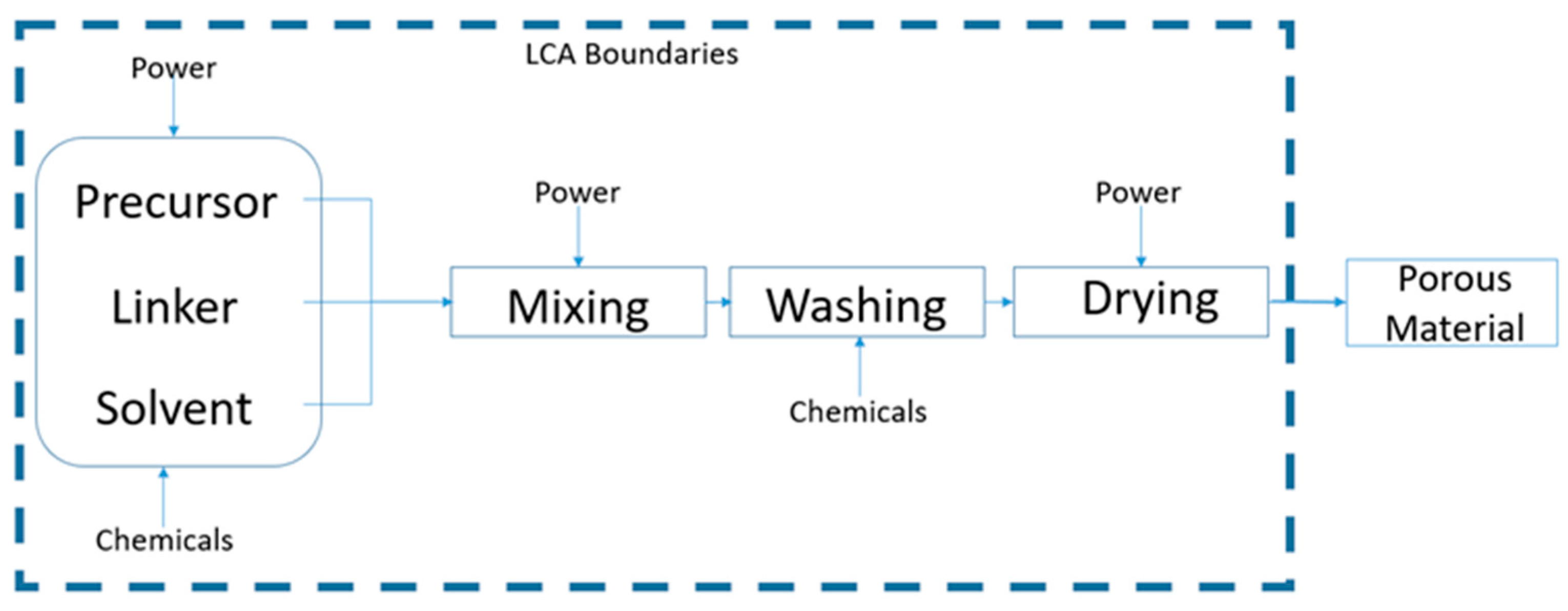
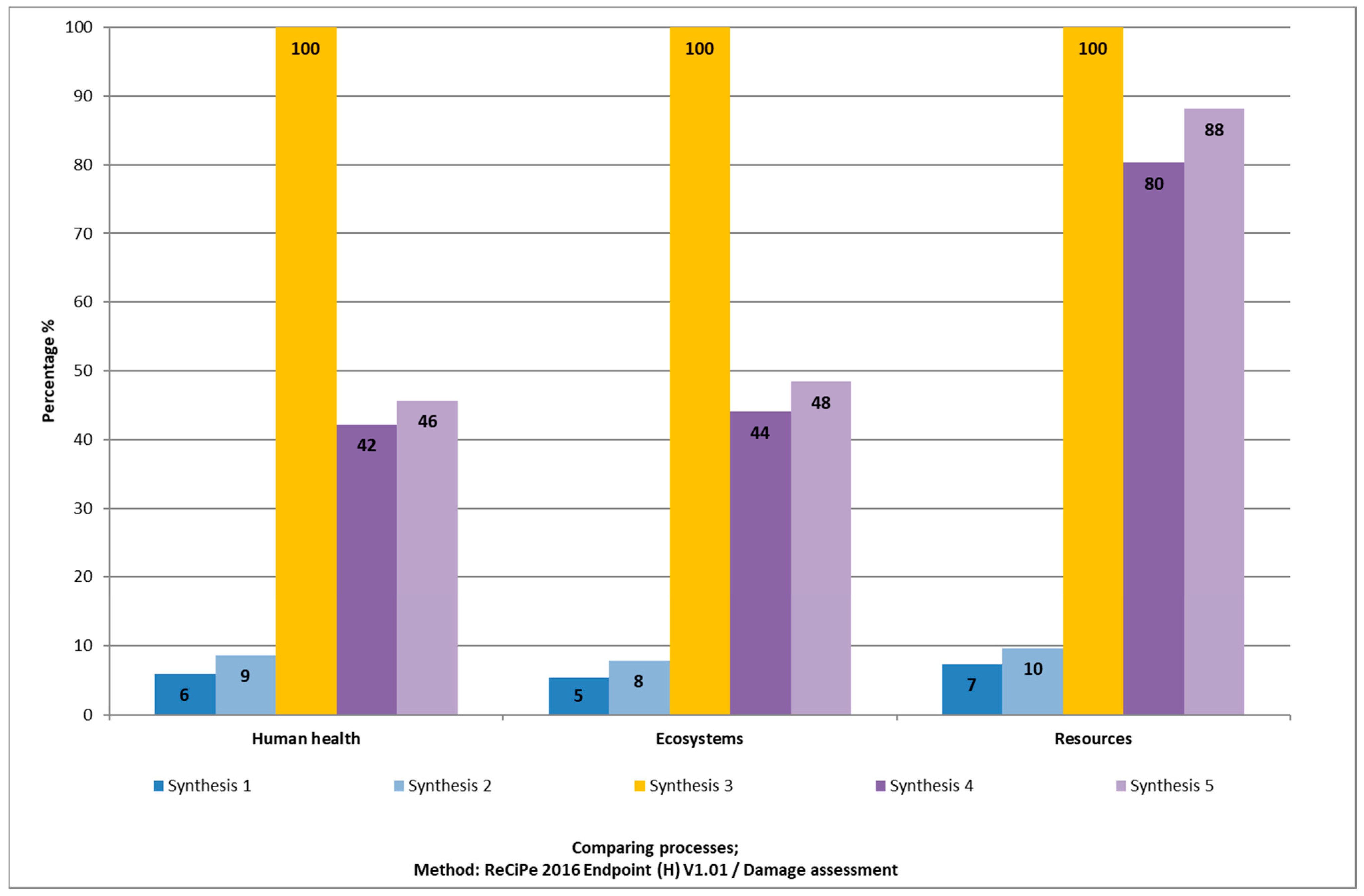
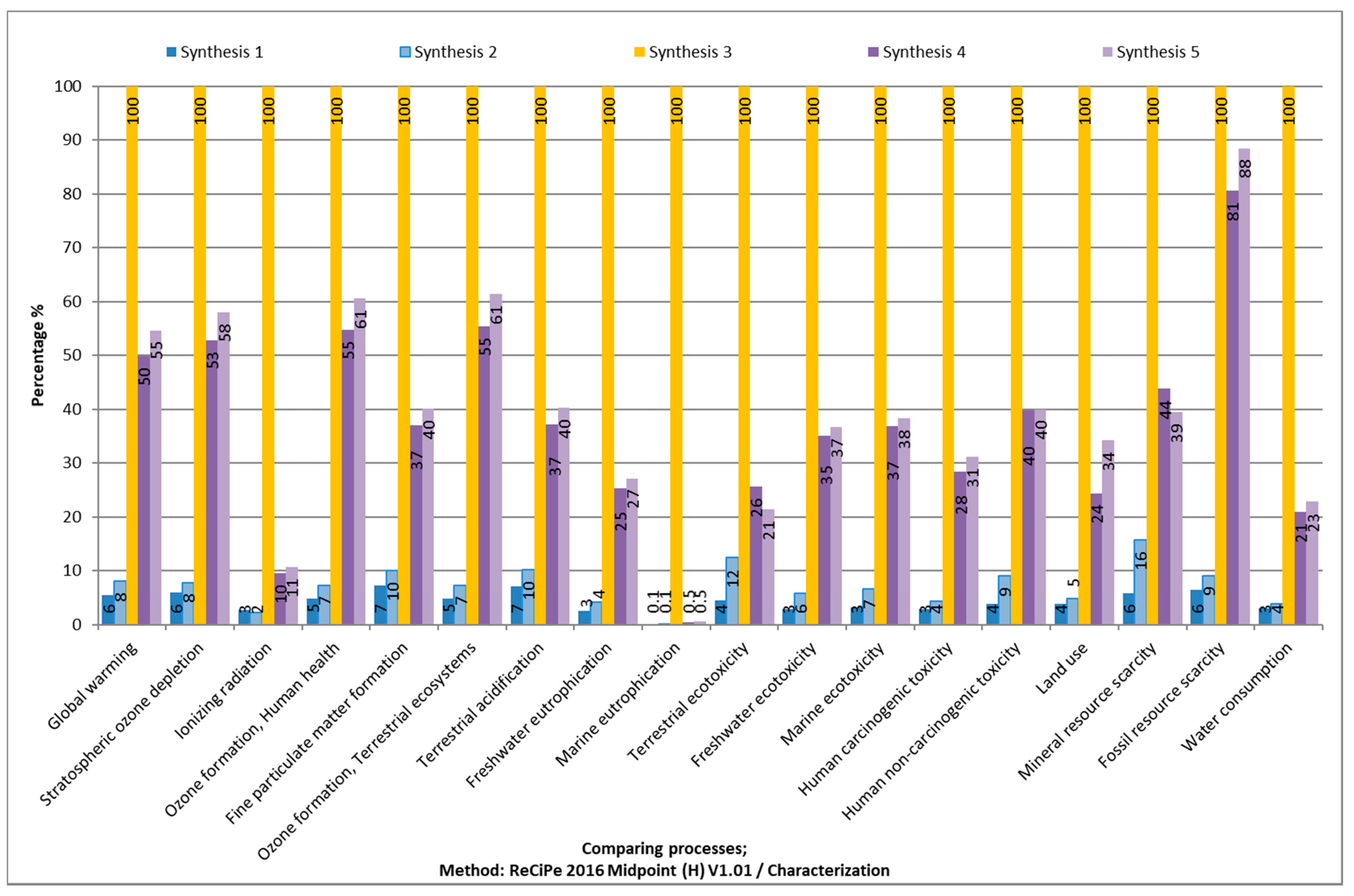
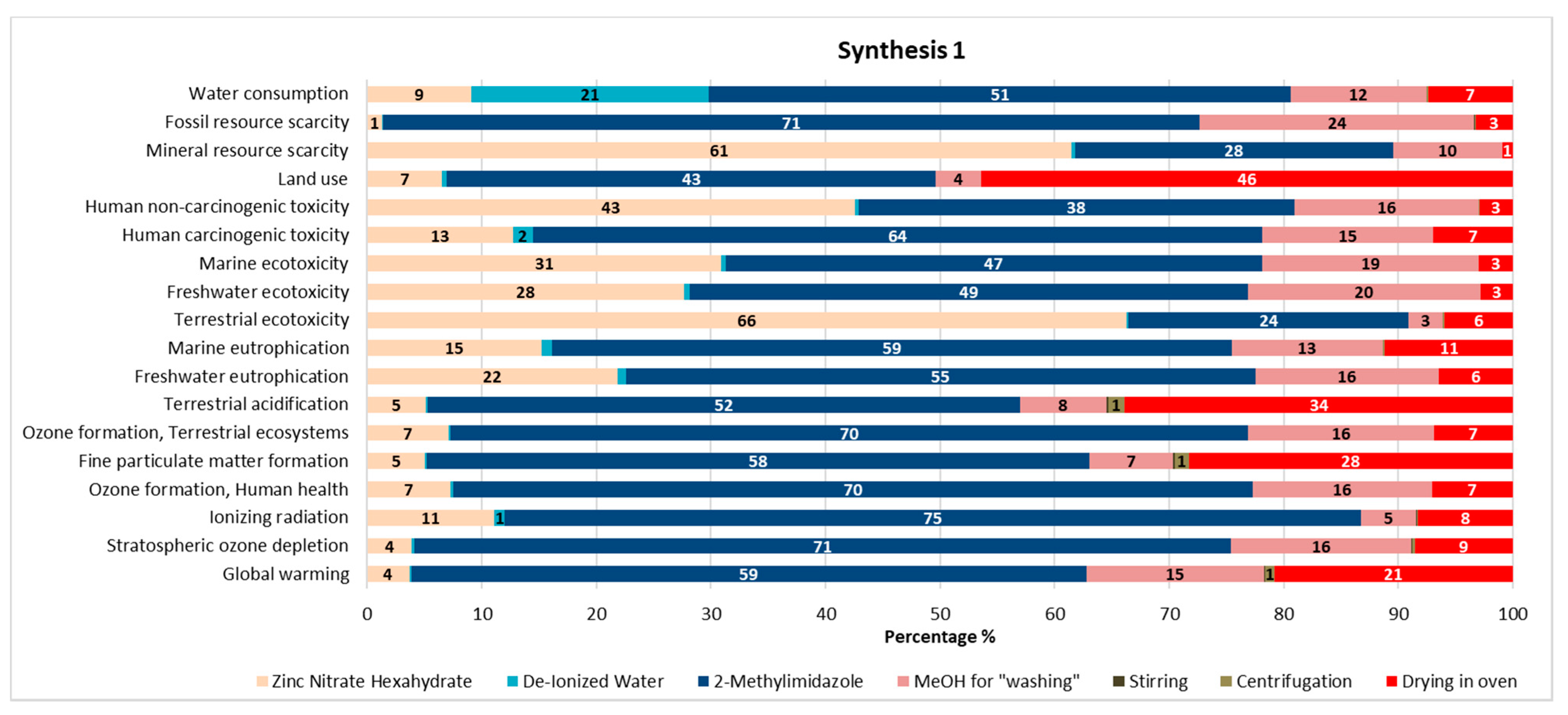
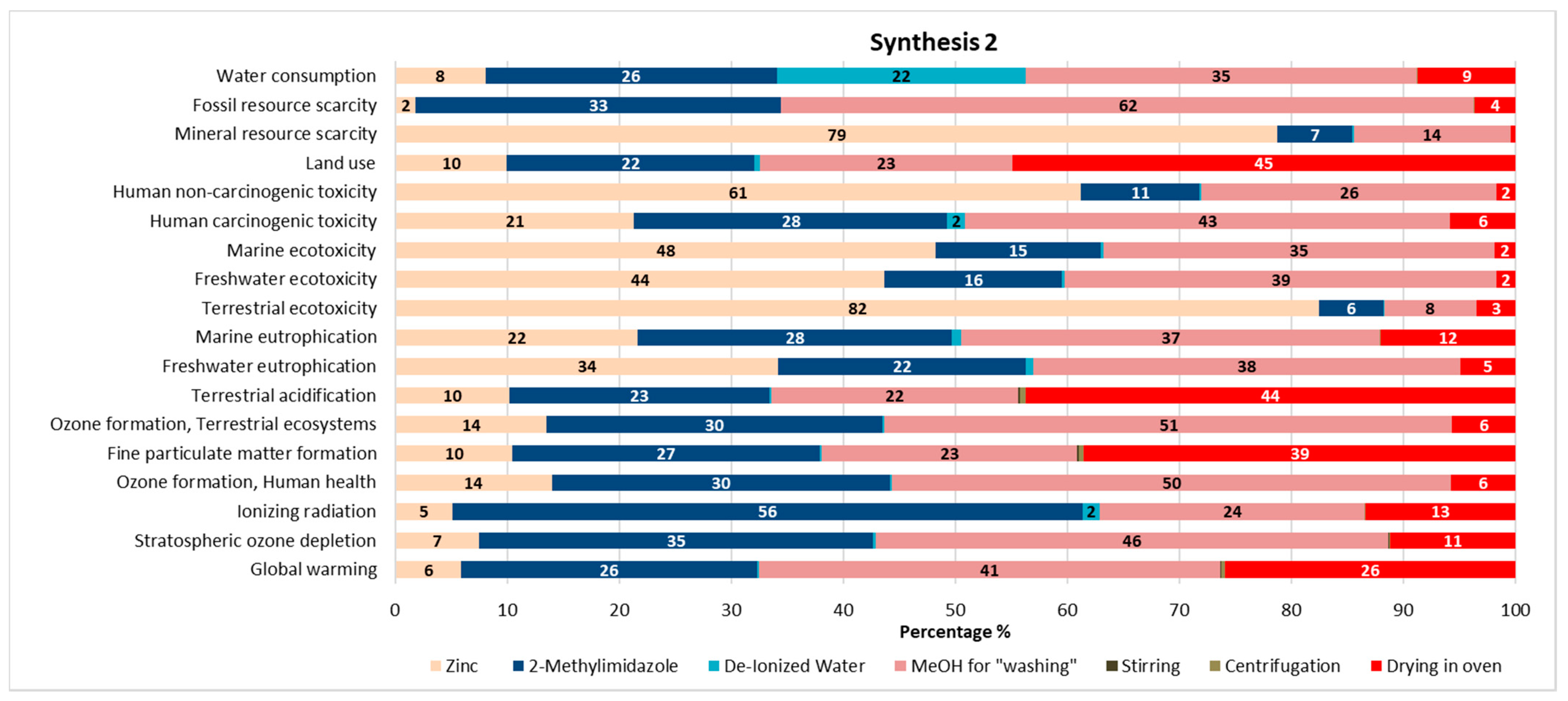
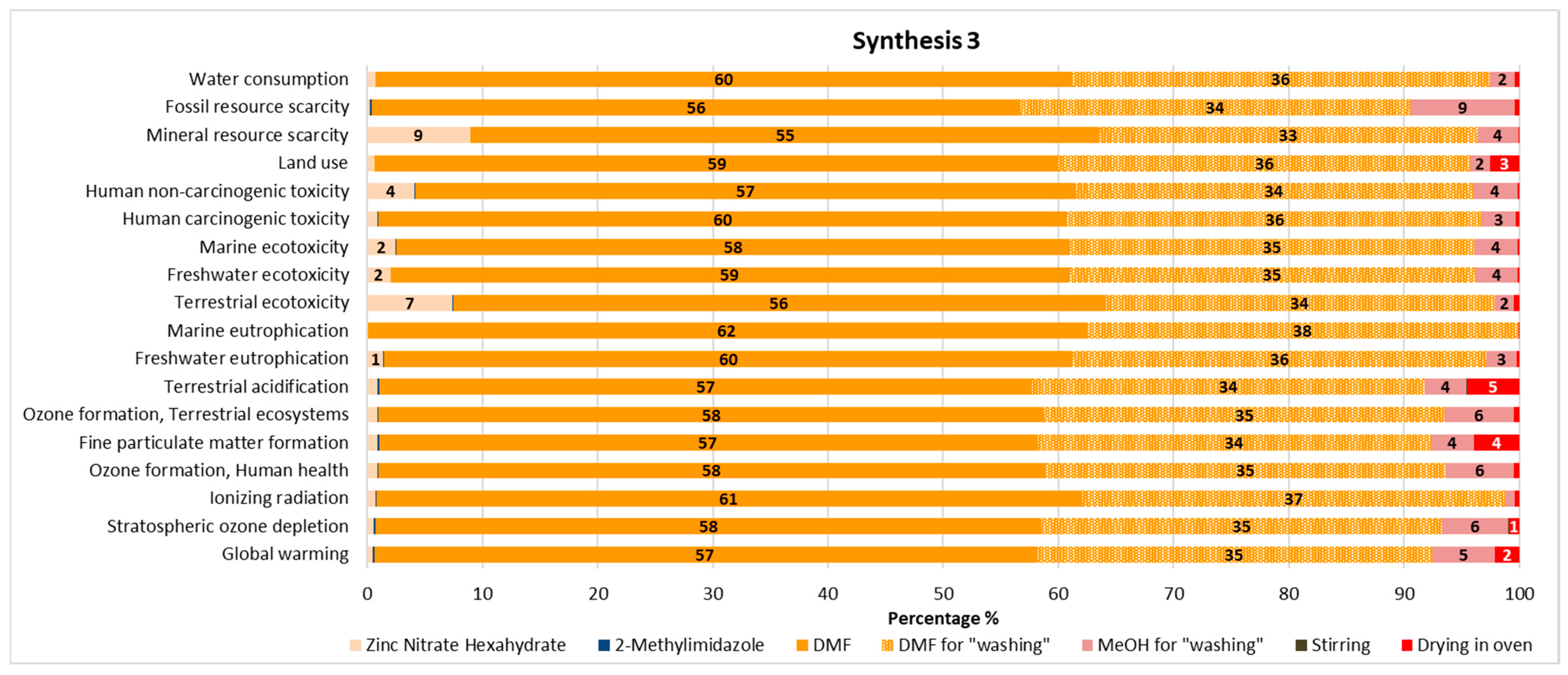
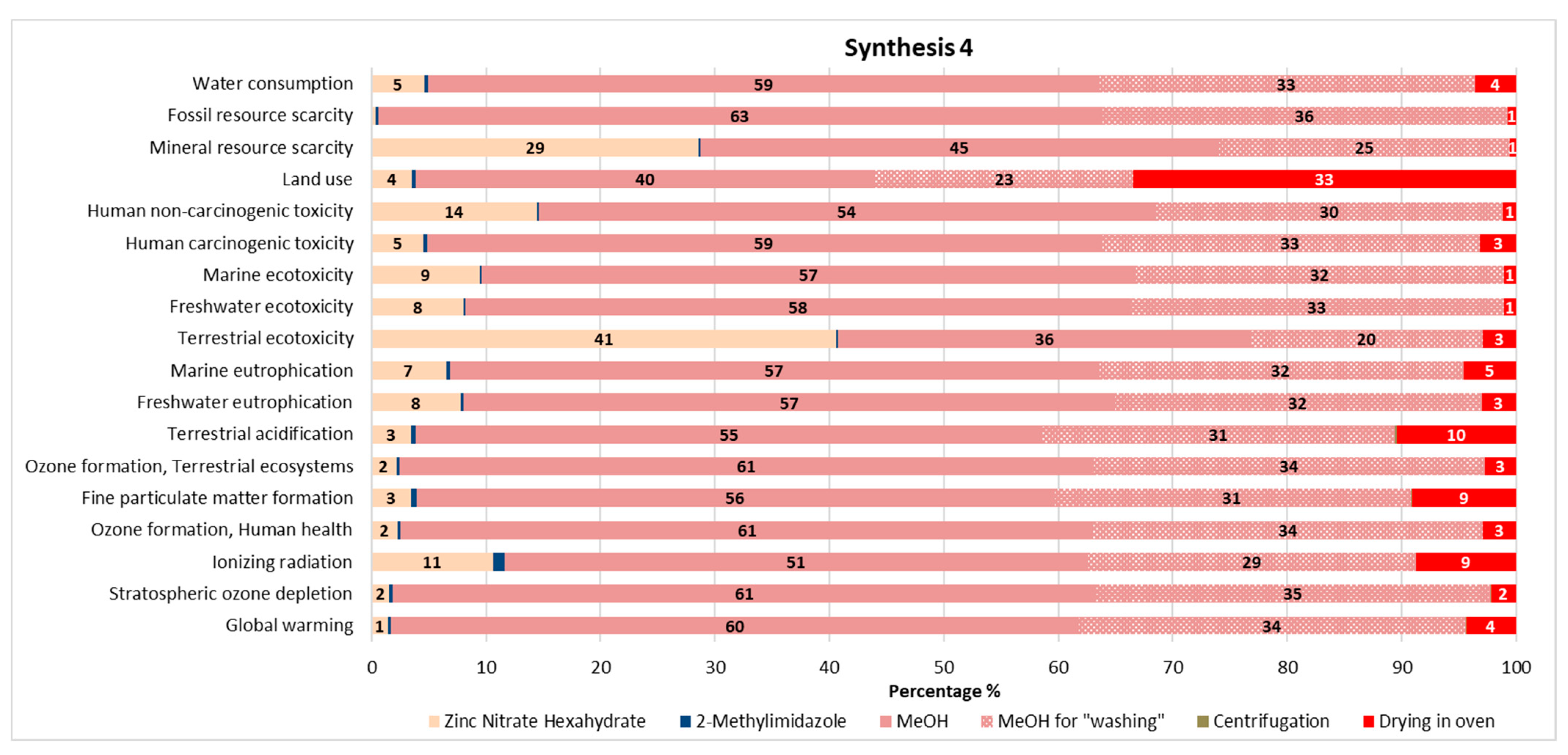
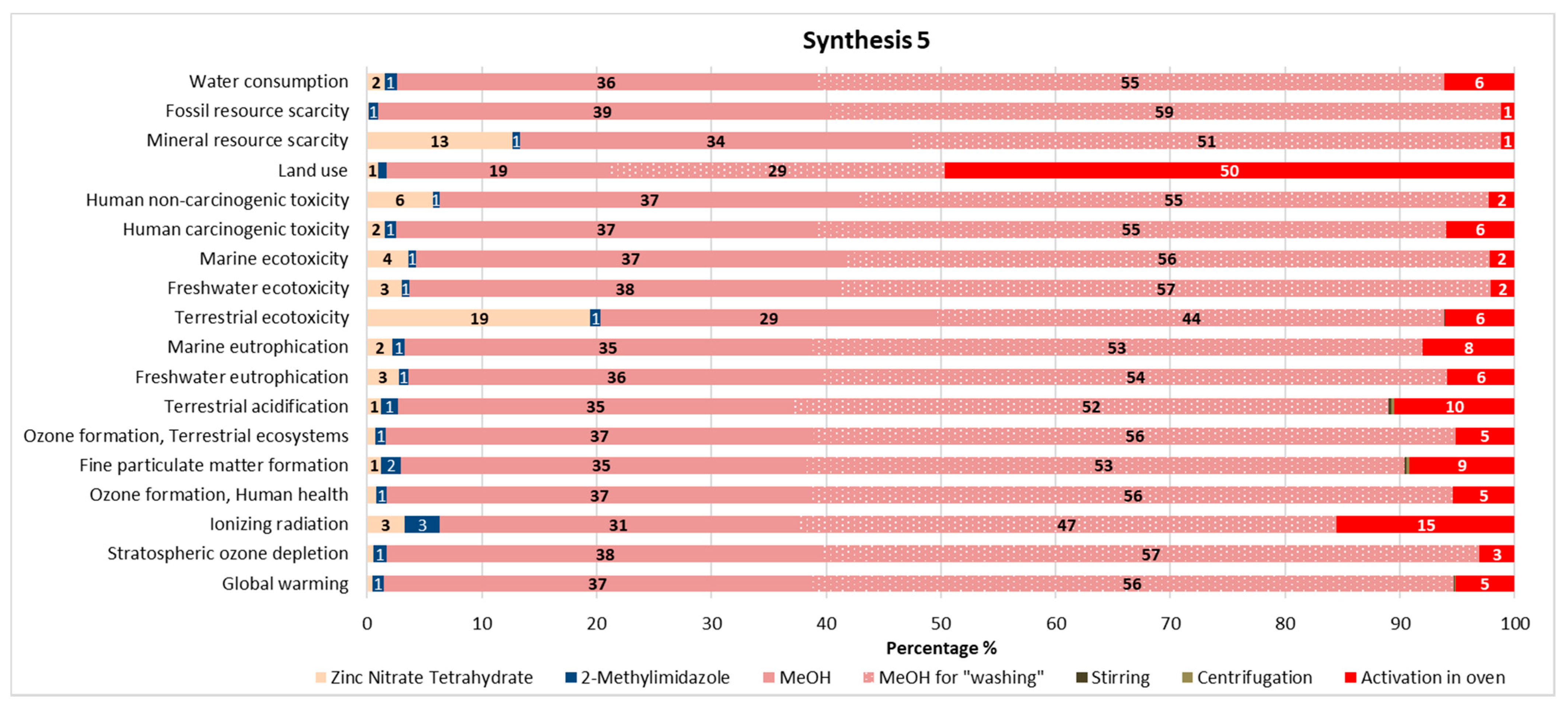
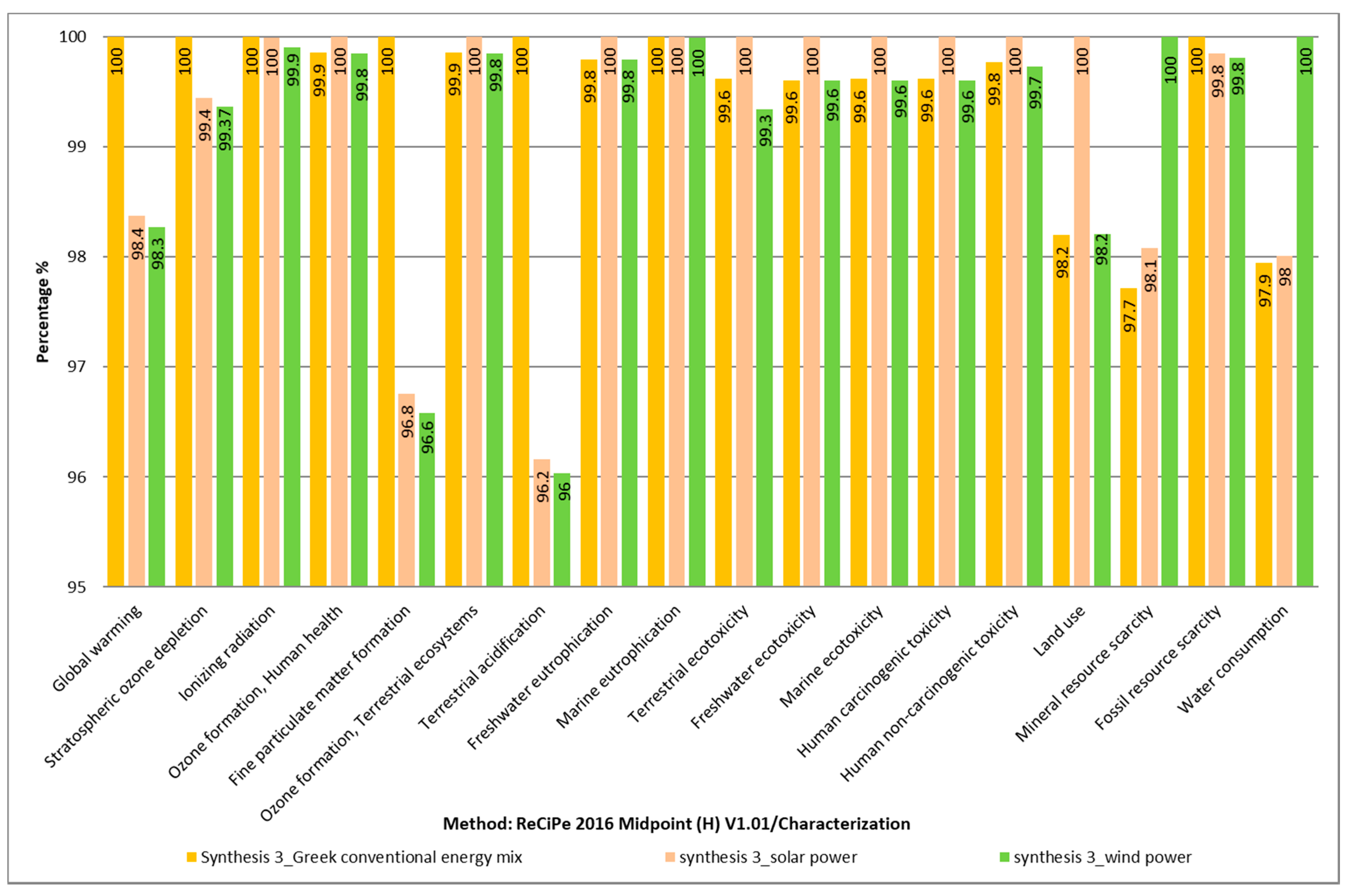
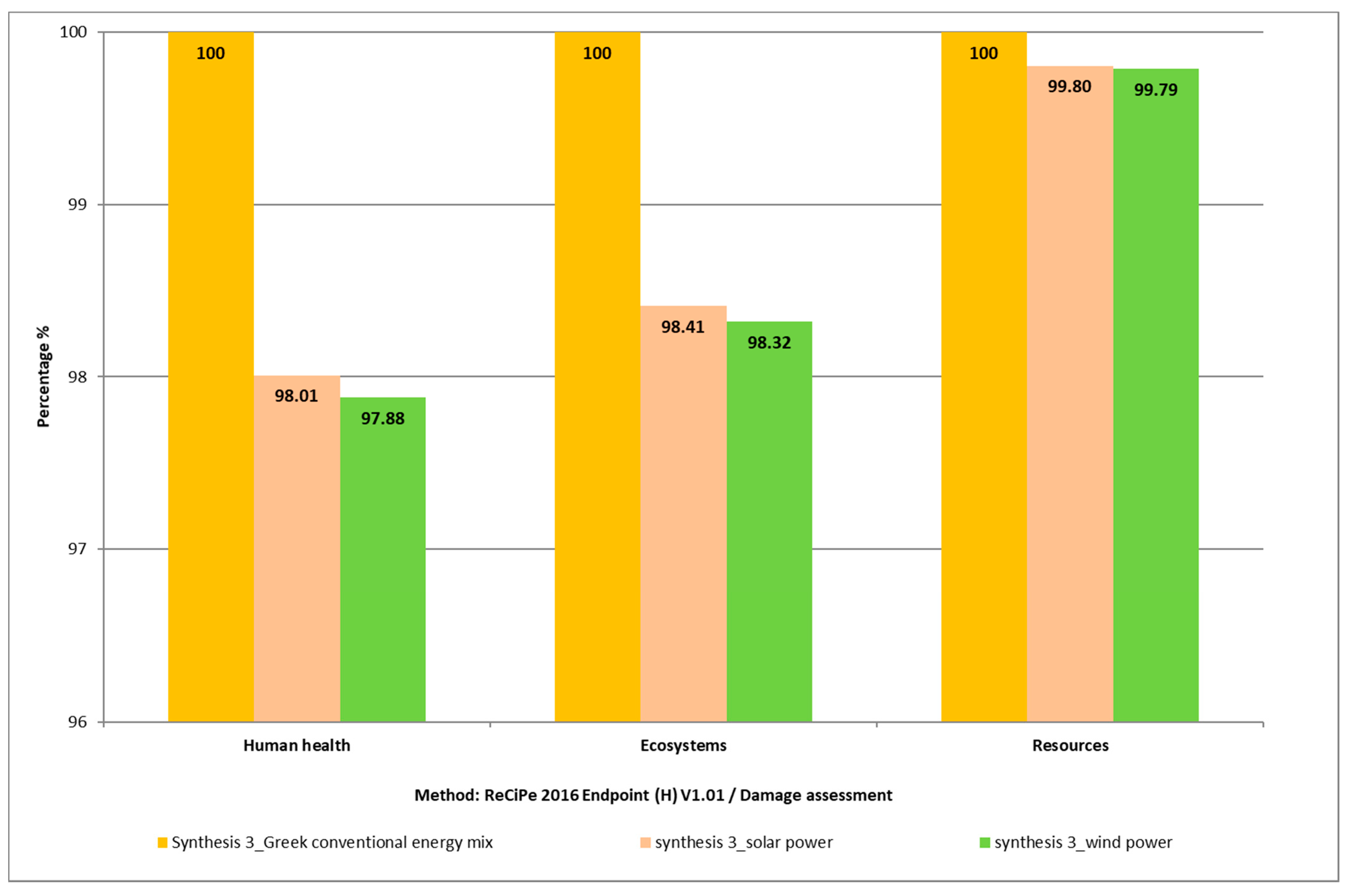
| Synthesis | Precursor (kg) | Mass Linker (kg) | Solvent for Synthesis (kg) | Solvent for Washing (kg) | Energy | Yield (%) | BET Surface Area (m2/g) | |
|---|---|---|---|---|---|---|---|---|
| Electricity (kWh) | Heat (MJ) | |||||||
| 1 | Zn(NO3)2 6H2O 1.921 | 37.274 | 144.5 De-Ionized water | 19.5 MeOH | 12.2 | 60.25 | 68 | 1424 |
| 2 | Zn 1.465 | 24.213 | 196.85 De-Ionized water | 70.08 MeOH | 23.4 | 73.03 | 89.6 | 1600 |
| 3 | Zn(NO3)2 6H2O 4.8 | 1.2 | 341.3 dimethylformamide (DMF) | 205.2 DMF | 23.2 | 86.3 | 60 | 1370 |
| 113.8 MeOH | ||||||||
| 4 | Zn(NO3)2 6H2O 6.732 | 1.678 | 636 MeOH | 357.7 MeOH | 11.8 | 278.5 | 43 | 1549 |
| 5 | Zn(NO3)2 4H2O 2.367 | 6.33 | 432.5 MeOH | 649.6 MeOH | 2.3 | 580.7 | 48 | 1605 |
| Impact Category | Unit | Synthesis 1 | Synthesis 2 | Synthesis 3 | Synthesis 4 | Synthesis 5 |
|---|---|---|---|---|---|---|
| Global warming | kg CO2 eq | 86.60 | 125.65 | 1571.16 | 782.57 | 858.25 |
| Stratospheric ozone depletion | kg CFC11 eq | 0.00 | 0.00 | 0.00 | 0.00 | 0.00 |
| Ionizing radiation | kBq Co-60 eq | 4.41 | 3.80 | 167.78 | 16.02 | 17.78 |
| Ozone formation, Human health | kg NOx eq | 0.13 | 0.20 | 2.76 | 1.51 | 1.67 |
| Fine particulate matter formation | kg PM2.5 eq | 0.16 | 0.22 | 2.21 | 0.82 | 0.89 |
| Ozone formation, Terrestrial ecosystems | kg NOx eq | 0.14 | 0.21 | 2.90 | 1.60 | 1.78 |
| Terrestrial acidification | kg SO2 eq | 0.41 | 0.60 | 5.88 | 2.19 | 2.36 |
| Freshwater eutrophication | kg P eq | 0.01 | 0.02 | 0.55 | 0.14 | 0.15 |
| Marine eutrophication | kg N eq | 0.00 | 0.00 | 1.67 | 0.01 | 0.01 |
| Terrestrial ecotoxicity | kg 1,4-DCB | 259.42 | 719.13 | 5798.03 | 1484.69 | 1236.89 |
| Freshwater ecotoxicity | kg 1,4-DCB | 1.34 | 2.68 | 46.13 | 16.13 | 16.91 |
| Marine ecotoxicity | kg 1,4-DCB | 2.07 | 4.29 | 64.58 | 23.80 | 24.72 |
| Human carcinogenic toxicity | kg 1,4-DCB | 1.37 | 2.02 | 47.61 | 13.51 | 14.79 |
| Human non-carcinogenic toxicity | kg 1,4-DCB | 53.88 | 125.85 | 1399.89 | 557.56 | 559.70 |
| Land use | m2a crop eq | 1.14 | 1.43 | 29.95 | 7.30 | 10.25 |
| Mineral resource scarcity | kg Cu eq | 0.30 | 0.80 | 5.12 | 2.24 | 2.02 |
| Fossil resource scarcity | kg oil eq | 61.32 | 87.21 | 962.58 | 775.49 | 851.39 |
| Water consumption | m3 | 0.72 | 0.92 | 23.81 | 4.98 | 5.43 |
| Impact Category | Unit | Synthesis 3_Greek Conventional Energy Mix | Synthesis 3_Solar Power | Synthesis 3_Wind Power |
|---|---|---|---|---|
| Global warming | kg CO2 eq | 1571.16 | 1545.6 | 1543.98 |
| Stratospheric ozone depletion | kg CFC11 eq | 0 | 0 | 0 |
| Ionizing radiation | kBq Co-60 eq | 167.78 | 167.77 | 167.61 |
| Ozone formation, Human health | kg NOx eq | 2.76 | 2.76 | 2.76 |
| Fine particulate matter formation | kg PM2.5 eq | 2.21 | 2.14 | 2.13 |
| Ozone formation, Terrestrial ecosystems | kg NOx eq | 2.9 | 2.9 | 2.9 |
| Terrestrial acidification | kg SO2 eq | 5.88 | 5.65 | 5.64 |
| Freshwater eutrophication | kg P eq | 0.55 | 0.55 | 0.55 |
| Marine eutrophication | kg N eq | 1.67 | 1.67 | 1.67 |
| Terrestrial ecotoxicity | kg 1,4-DCB | 5798.03 | 5820.31 | 5782.1 |
| Freshwater ecotoxicity | kg 1,4-DCB | 46.13 | 46.31 | 46.13 |
| Marine ecotoxicity | kg 1,4-DCB | 64.58 | 64.82 | 64.57 |
| Human carcinogenic toxicity | kg 1,4-DCB | 47.61 | 47.79 | 47.6 |
| Human non-carcinogenic toxicity | kg 1,4-DCB | 1399.89 | 1403.08 | 1399.3 |
| Land use | m2a crop eq | 29.95 | 30.5 | 29.96 |
| Mineral resource scarcity | kg Cu eq | 5.12 | 5.14 | 5.24 |
| Fossil resource scarcity | kg oil eq | 962.58 | 961.11 | 960.71 |
| Water consumption | m3 | 23.81 | 23.82 | 24.31 |
Publisher’s Note: MDPI stays neutral with regard to jurisdictional claims in published maps and institutional affiliations. |
© 2021 by the authors. Licensee MDPI, Basel, Switzerland. This article is an open access article distributed under the terms and conditions of the Creative Commons Attribution (CC BY) license (https://creativecommons.org/licenses/by/4.0/).
Share and Cite
Ntouros, V.; Kousis, I.; Papadaki, D.; Pisello, A.L.; Assimakopoulos, M.N. Life Cycle Assessment on Different Synthetic Routes of ZIF-8 Nanomaterials. Energies 2021, 14, 4998. https://doi.org/10.3390/en14164998
Ntouros V, Kousis I, Papadaki D, Pisello AL, Assimakopoulos MN. Life Cycle Assessment on Different Synthetic Routes of ZIF-8 Nanomaterials. Energies. 2021; 14(16):4998. https://doi.org/10.3390/en14164998
Chicago/Turabian StyleNtouros, Vasileios, Ioannis Kousis, Dimitra Papadaki, Anna Laura Pisello, and Margarita Niki Assimakopoulos. 2021. "Life Cycle Assessment on Different Synthetic Routes of ZIF-8 Nanomaterials" Energies 14, no. 16: 4998. https://doi.org/10.3390/en14164998
APA StyleNtouros, V., Kousis, I., Papadaki, D., Pisello, A. L., & Assimakopoulos, M. N. (2021). Life Cycle Assessment on Different Synthetic Routes of ZIF-8 Nanomaterials. Energies, 14(16), 4998. https://doi.org/10.3390/en14164998










